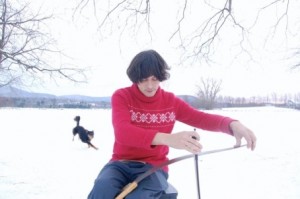One of the great recent additions to the library of Christmas music is Julian Koster‘s The Singing Saw at Christmastime. It’s hard to imagine that it’s the first album of Christmas songs played on a saw—it seems like someone must have cut such an album for a regional label in 1940s or ’50s—and it’s a must for those who tap easily into the eerie, melancholy side of Christmas music. His lonely saw sounds right at home next to the banks of haunted, disembodied voices that coo like snowy wind on the Jackie Gleason Christmas songs recorded in the mid-1950s. Koster is the saw and banjo player with Neutral Milk Hotel, and while his holiday tour brings him nowhere near New Orleans (maybe next year), he brings an interesting perspective to Christmas music.
Is it hard to play the saw with a band?
No, especially not in the context that we’re doing it because we’re not very loud. The loudest things we have are horns. Otherwise, the saw itself is actually pretty hearty. Loud voicing and with the loud venue tours that we do, it’s still not bad because there’s a secret to mic’ing it, which helps a lot—micing it from underneath the saw. You bend the saw over the mic.
Is it hard to play the saw in tune with the rest of the band?
No, especially if you can hear yourself. The hardest situations for venue touring when you’re doing really loud stuff is when you simply cannot hear yourself at all. But like with everything else in life, experience helps a lot. I feel like these days when that happens, you almost feel the vibrations in your hand and you can tell whether those are the right vibrations or not.
How long have you been playing the saw?
Pretty much since I was a little kid.
Were you prompted by the novelty of it?
Well, I saw it done and it astonished me and almost broke my heart at the same time, in a good way. I couldn’t believe it was real. I had no context for it. I had never imagined such a thing had existed. It was an old man playing the saw, and it was one of the most beautiful sounds I had ever heard and it seemed unreal. I thought it was a magic trick.
After watching him for a long time, I at least began to accept its reality and I was left with this crazy hunger, this almost insatiable yearning that didn’t go away until I was able to do it myself because I felt that I just had to do that. There was nothing in the world I have never felt so strongly that I wanted to do. Thank goodness I saw him; it was a special moment in my childhood.
How long did it take to get good at it?
Well it depends on your definition of “good,” I guess. It’s something that never stops getting better, ever. You’re continually finding the saw is getting more and more expressive and more and more nuanced and able to do new things you had no idea it could do the longer you spent playing it. The thing is, if you love the phenomenon, if you love the sound, you’re just enchanted no matter how it sounds. And of course the more you do something lovingly, the better and better you get until you’re highly skilled.
When could you play things that people could clearly recognize what you were playing?
It didn’t take me too long for that. My problem was I taught myself to play in a very illogical, crazy way that hurt a lot. My problem was that people could generally understand what I was playing. It was almost a masochistic ritual. I was straightened out by a beautiful soul, this elderly fellow named Moses Josiah who lived in Brownsville up in the roadhouses in New York. I went out to see him on a little pilgrimage. He’d done a lot of the ‘40s and ‘50s Disney soundtracks. Walt Disney gave him a golden saw, a gold-plated saw. He lived out there with his family, this really lovely older Jamaican gentleman. He showed me how he played which made a lot more physical sense in terms of the layout of the human body. We have very different approaches to sound, but I play with the same hand positions that he does because it really made a huge difference.
When did the idea of doing the Christmas record come around?
I wanted to do that during a period of time when I was being a hermit. I was living on this island in Maine, and we hadn’t toured for a few years. I was just recording and being on the island. I collect a lot of kids’ records from the ‘30s, ‘40s ‘50s, ‘60s, and I collect Christmas records at Goodwill. I take a lot of pleasure in them. I saw the albums sitting there one day and I looked over and imagined the cover. I saw the record and thought, “God I’d really love to make that.”
All this time, I’d been making this record of songs for Merge that I was taking my time on. I spent years on it, basically, so I felt embarrassed to even call them because I owed them a record for so long. I waited until I finished that record and then I just mentioned it to them. They called me back a while a later and were like, “Okay, we want to do that and we want to do the Christmas record. Can you have it in by…?” I forget what the date was, but it was some date that was astonishingly soon for something that hadn’t even been begun. I was stunned. Half of my recording machines were broken.
It was a really funny time. It was spring on the island I was living on, and the island I was living on is deserted during the winter usually, but it’s a big summer place. The landscaping companies were being sent over to the island to prepare the houses, so there were all these lawn mowers going. The island and the ocean sound tropical, so if there was a lawn mower anywhere on the island when I was playing the saw—which leaves a lot of space for other sounds to a microphone—you could hear lawn mowers, and you could hear flies buzzing, and you could hear birds singing, all of which are things you just can’t have on a Christmas record. Basically, I had to stay up all night. The recording process happened overnight. A lot of times I’d been really close to getting something done and really excited, and suddenly, “EHHHHHH. The lawn mower would start at 7 in the morning and I’d been like, “Gotta stop. Gotta go to bed.” It was really fun; it was a really crazy time.
Well, there’s a proud tradition of that with the Christmas record being cut in the middle of summer. That was traditionally when people would cut Christmas records, so you could have it ready in time for Christmas release.
It’s definitely a privilege being a part of that tradition.
What do you love about Christmas records, especially the ones you find in second hand stores or Goodwills?
Oh god, the feeling. And it is such a powerful feeling. Those records are kind of like artifacts, which is what I wanted to make. If it was up to me, I’d be making a lot more Christmas records—I don’t know how Merge would feel about it. A lot of those records are these little artifacts from another time and another place, but containing that same feeling that you’ve known of love since I was a kid. It feels like being invited into someone’s home and shown their world, but shown that warmth. The kind of warmth that you’re shown as a little kid at these things. It’s like an organ and chimes Christmas record in Michigan in 1940, or a children’s choir where a third of the kids sing off-key recorded in Texas, or French kids… The variety is unbelievable of these records and the places, and the circumstances that they come from. But they all have this really sweet, noble feeling in common that is one of the nicest feelings that human beings are able to produce among themselves.
I’ve been listening to the Line Material Christmas records—Christmas songs contracted by a company—and they highlight something I love about Christmas music. It’s one of the places where you find the marketplace and companies at their most human. The songs are a reminder of a way of doing business that doesn’t exist anymore. You couldn’t imagine Hertz making a Christmas record. Older records tap into a world that you have a hard time imagining existing anymore.
Except that we’re the same creatures. We still have that real goodwill and kindness inside of us. We’re all capable of it. But it exists very directly in those records. But I agree completely. That’s exactly the way I feel too.
I listen to these records all times of the year, I should point out, which makes me kind of unusual. But I feel like what makes a Billie Holiday recording great or what makes a great Ornette Coleman recording is the feeling. Any time someone plays something really great, they have that feeling. I think the nice thing is when that company contracts those people to make that record, it’s like everybody knows that feeling. They can access that feeling, and that’s part of what makes it so great is that, everybody goes to that place no matter who they are. It’s like a studio musician or an elementary school kid, or whatever it is—we know that place and they go there. And it shows up on the recording, and it’s really special.
I think Christmas records are a great challenge for a musician because these are songs people have known all their lives. The question is always, what do you do to give your version a reason to exist? As much as artists are working in the most conventional music, they’re forced to be at their most creative. Or to cop out entirely and suck, both of which happen.
I think it forces people to be themselves in a lot ways, which is a funny thing to say. All you really have to go on is that you’re unique. You’ve never existed before. You’ve got your soul, and you’ve got your life and your body. I think what happens is, if it’s an honest thing, if you feel that feeling and you love that song and you honestly render it, then it becomes original. Because you’ve never existed before, so neither has your true version of it.
[youtube]http://www.youtube.com/watch?v=Qrt822SsTIY[/youtube]





